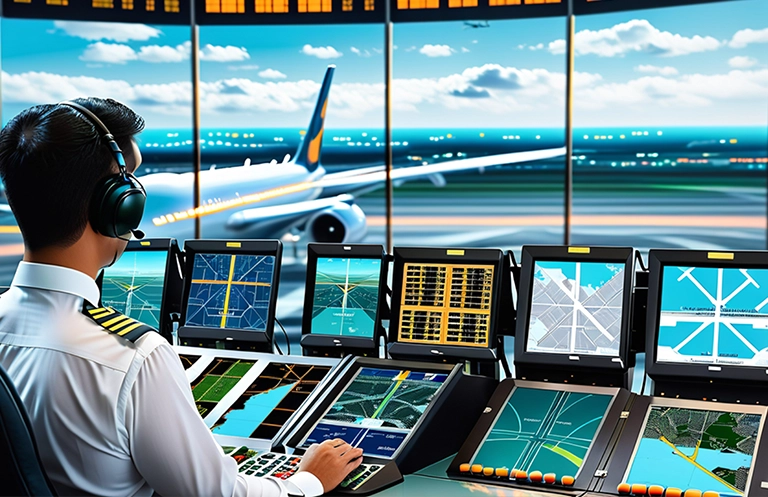On the night of July 1, 2002, when a Boeing 757 crashed with a Tupolev-154 at 35,000 feet over the towns of Überlingen and Owingen, in southern Germany, 71 lives were lost. Based on the investigation report by German Federal Bureau of Aircraft Accident Investigation, ATC could not identify that the two aircrafts were violating the minimum required separation distance. At the time, when prescribed separation was being violated, Tupolev-154 was instructed to descend by ATC. The crew followed this instruction even when TCAS advised them to ascend, not descend. TU154M crew would have followed TCAS if the controller had not earlier instructed manoeuvre in the form of descent.
The ATC’s job is very crucial and important:
- To manage the movement of the aircraft in and out of the airport area.
- To direct pilots during take-off and landing, and screen the aircraft as they travel through the skies. While performing these critical tasks
- To rely on different components including radio frequencies to arrange communication between pilots and other crash alert systems that notify aircraft collisions.
Such simultaneous interactions between human operators and machines are needed to maintain the continuous cycle of air safety which was broken on that fatal day of the crash. ATCs are primarily focused on safety, but their other routine tasks involve directing aircraft efficiently to minimize delays and taking care of high traffic situations.
At the time when Boeing 757 crash incident occurred, TCAS II version 7.0 was implemented. Soon, it had to be revised to TCAS II version 7.1 with logical changes in the year 2008 and became fully operational by 2010-2011 to take into account early warning detection. All new aircraft since March 2012 are fitted with TCAS II version 7.1 which includes this reversal logic, and existing aircraft must be upgraded before December 2015.
Nowadays, all aircrafts are fitted with Traffic Collision Avoidance Systems II version 7.1 (TCAS II) to reduce the possibility of mid-air –collisions. They should not only alert crew before collisions but also provide the best escape path with the aid of an operating transponder independent of ATC. Further, they must warn pilots about the presence of other transponder-equipped aircraft. ACAS/TCAS are built on the signals of secondary surveillance radar (SSR) transponder. But they operate independently in guiding the pilot from preventing collisions with the aircraft.
Traffic Collision Avoidance Systems II (TCAS II):
All aircrafts that are equipped with an appropriate transponder, can communicate with each other with the help of TCAS. The aircraft intermittently broadcasts the interrogation signal. Thus, every aircraft can interrogate all other aircrafts about their locations at fixed range and other aircraft have to swiftly reply to such interrogations. The power of interrogation signal is less strong than on ground.
But, it is still sufficient to trigger response from the aircraft that may be less than a minute of flight. The difference between distance and altitude is tracked to identify the drift. Closure rate is determined from a consecutive distance. The time to closest point of approach (CTA) is approximated with the help of closure rates and current distance. It can be achieved by dividing the current distance range by closure rate, the result is called ‘range tau’ (τ). The same procedure is done at vertical planes. Vertical tau can be obtained by dividing difference in altitude by vertical speed difference.

A Traffic Alert (TA) is raised if both τ values are less than a certain threshold. Resolution Advisory (RA) is given when the value of τ is less than another (lower) threshold. The TA is considered a ‘heads up’ indication of whether the RA is able to follow the instruction of reducing the collision risks that must be followed by the pilot. The threshold time usually ranges from 22 seconds to 45 seconds for TA’s and from 12 seconds to 32 seconds for RA’s. But the avoiding action is not indicated. TCAS creates 3D map of the aircraft in airspace based on the responses, round trip time, and interrogated aircraft’s altitude. Thus, this difference between current range and future values confirms any possible collision threat.
Based on the capabilities introduced by National Airspace System, TCAS needs to be upgraded. The aircraft can be tracked with a higher accuracy than using radar with the help of satellite-based technologies. By using SATCOM, the safe separation distance can be reduced. Thus, we can get aircraft through busy airspace more efficiently.
Even after a recent incident where the Malaysian aircraft, MH370, disappeared on 8 March 2014 while flying, companies have been trying to figure out new ways of establishing communication so that such incidents do not repeat. NextGen suggests using satellite-based air traffic control system instead of radar-based system with radio communication. To shorten routes, save time and fuel, decrease traffic delays, improve capacity, and certify controllers to observe and manage aircraft with greater safety restrictions, GPS technology has to be used. Radio communications will be increasingly replaced by data exchange and automation. It will reduce the amount of information the air crew must process at one time.
Leveraging our end-to-end technology capability coupled with in-depth aerospace domain and process (DO-178B/C, DO-254, and DO-160) expertise, eInfochips has supported DO-254 design and verification for next Generation Iridium based SATCOM for transport aircraft. To know more about technical steps taken by eInfochips to reduce mid-air collisions, email us atmarketing@einfochips.com













